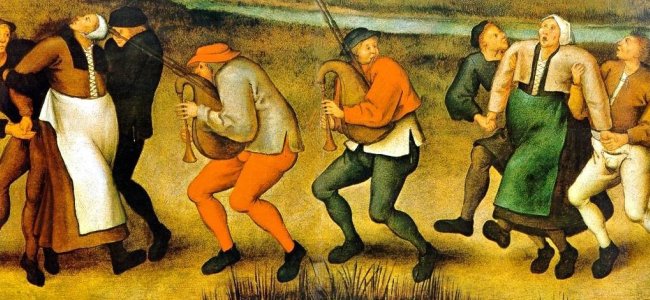
En medio de la reforma protestante, con el descubrimiento de las Américas en pleno auge, con los Otomanos llamando a las puertas de Europa... a los habitantes de Estrasburgo les dio por bailar. Y no es que el pueblo tuviera motivos para la alegría, es que el baile de San Vito había llegado a la ciudad, una temible epidemia, que al menos vista desde fuera, no parecía tan mala. Y es que en julio de 1518, una señora de nombre Frau Troffea se dio repentinamente al baile apasionado, algo que la tuvo casi sin parar ni a comer durante al menos cuatro días y que congregó a más de 400 vecinos moviendo el esqueleto para finales de mes.
Esta aparente locura colectiva acabo llamando la atención de las autoridades, que convocaron un consejo médico para hallar soluciones. Y vaya que si lo solucionaron. Se habilitaron salones de baile, se construyó un escenario de madera para dar cabida a todos los danzarines, se contrataron músicos que acompañaran los movimientos e incluso se llamó a bailarines profesionales para que pusieran un poco de elegancia en aquel desbarajuste de coreografía.
Y ante este panorama, pues claro, para finales de verano media Francia se habíaapuntado a la epidemia de bailes. Pero no hay cuerpo que aguante este ritmo, y los bailarines empezaron a morir de hemorragias cerebrales, ictus isquémicos o de simple agotamiento. Muchos de los supervivientes fueron llevados a capillas e iglesias dedicadas al culto de San Vito. El por qué de los atributos danzarines de este santo lo encontramos en Letonia, donde al parecer, durante la Edad Media se celebraba la festividad de San Vito bailando ante su estatua. De ahí que los bailarines hayan acabado heredándolo como patrono (y también los epilépticos). A finales de septiembre, con ayuda del santo o sin ella, la extraña epidemia bajó el telón.
Sin embargo, pese a lo raro del fenómeno, no se trata de algo tan único como podría esperarse. Hay datos de que en la cuenca del río Rin ya habían vivido, hacia 1374, una epidemia de bailes muy similar. Y durante el siglo XV hay constancia de diversos brotes, y quizás del más extraño de ellos. En 1491 un convento de monjas sufrió la posesión de varias hermanas por algún tipo de enfermedad que las hacía comportarse como gatos, perros o pájaros indistintamente. Habiendo sido todos estos fenómenos documentados por médicos, clérigos e historiadores de la época.
¿Qué hay detrás de estas epidemias de baile?
Aunque las teorías postuladas son muy diversas, parece que se ha llegado a un consenso entre psicólogos, historiadores y antropólogos para decantarse por la opción que tal vez sea menos objetivable a día de hoy. Se descartó la intoxicación por el hongo del cornezuelo del centeno porque las sustancias psicotrópicas podrían explicar el comportamiento y las alucinaciones, pero también dificultarían mucho el movimiento puesto que el dolor provocado por la isquemia distal en el ergotismo es bastante intenso.
 |
Niño con corea. Posiblemente por fiebre reumática postfaringoamigdalítica debida a S. pyogenes. Descartada como causa de aquellos episodios por su epidemiología prevalente en niños
|
Queda entonces la explicación psiquiátrica, un trastorno psicogénico masivo, una histeria colectiva desencadenada tras largos periodos de estrés y condiciones pésimas. Y es que en la Europa del siglo XV eran el pan nuestro de cada día las sucesiones de hambrunas, las inclemencias climatológicas, la alta mortalidad por la lepra y la viruela, la recién llegada sífilis, el hacinamiento, la insalubridad...
En definitiva, que hasta las monjas tenían motivo de queja, puesto que la mayoría de ellas adoptaban la vida monástica por obligación y las que no, no paraban de atormentarse con la idea de no ser lo suficientemente devotas.
Por lo tanto el famoso mal de la chorea sancti viti se refirió a un cuadro de manía danzante, un trastorno histérico colectivo que parece haber sido muy común durante los siglos XV y XVI pero que ahora está extinguido. Durante la época, se llamó a estos episodios corea magna y se reservó el término de "corea menor" para la enfermedad que hoy conocemos como tal, la corea de Sydenham. Mientras que el término de "corea mayor" ha pasado a denominar a otro trastorno motor, la corea de Huntington.


